Currant glass: what is it and how to fight?
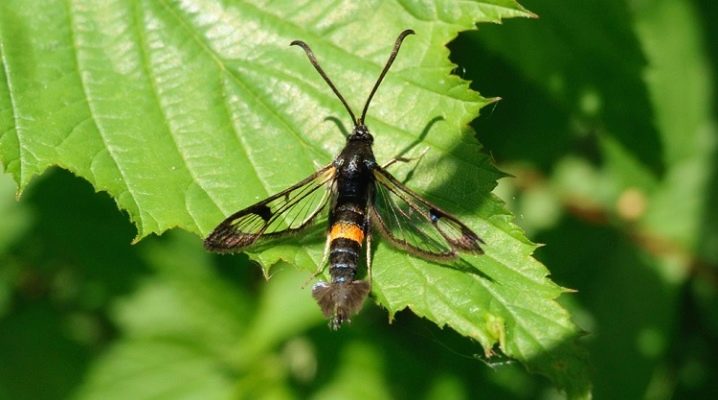
Currant glass is an insect that can destroy the entire crop. Let's figure out what signs are characteristic of glass disease and how to treat bushes affected by the pest.
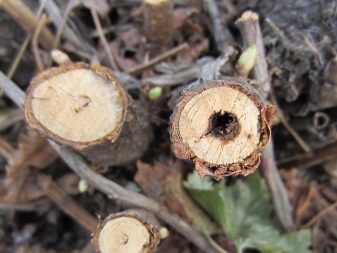
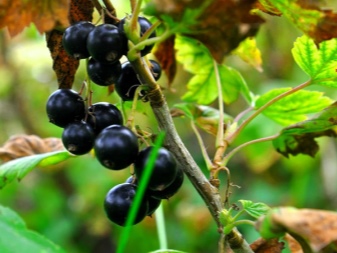
What it is?
Visually, the glass beetle is similar to a wasp: it looks like a small insect with an oblong body, the length of which does not exceed 1 cm. Its body is painted black, its wings are transparent with a bright orange edging. Females have 3 thin yellow stripes on their bodies, and males - 4. The pest feeds on pollen from inflorescences during the period of active flowering and currant juice.
It is not the glass butterflies themselves, but their larvae, that inflict great damage on the fruit shrubs. The insect lays eggs in the bark of the shoots in May-June. One individual makes a clutch of 50-60 eggs. After about 2 weeks, beige caterpillars emerge from them. Adults reach 2.5 cm in length. Their food is the trunk and bark of the currant. Getting food, they make moves in the thickness of the stem and quickly reach its core. At the same time, glass cases affect not only currants, but also raspberries with gooseberries.
The branches affected by the pest stop growing, they gradually wither, dry out and break off. When cut, a blackening of the core can be found on the shoot, and in the middle there is a small hole (the course of the larva). The defeat of the shrub is also evidenced by small increments that are visible in the fall.
Glass beads on currants are dangerous, and if untreated, it leads to sad consequences - it affects up to 50% of the branches of the shrub under stable warm weather conditions.
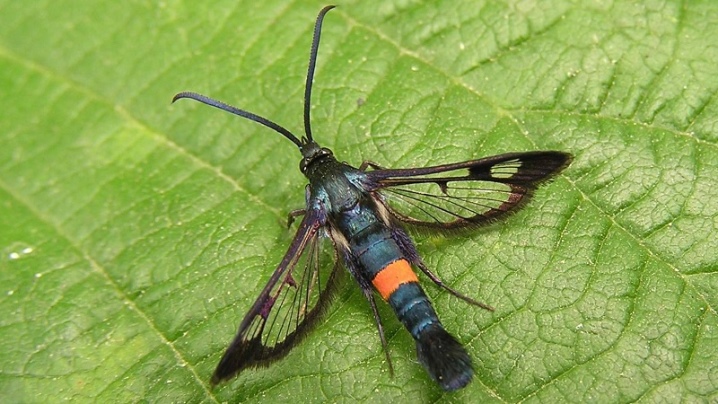
Processing time
Glassware is active in mid-spring and early summer. Already in April-May (depending on the region) insects attack the blossoming inflorescences on currant shoots and lay eggs. That is why gardeners are advised to process shrubs in the spring. However, before that, the currants need to be prepared. To do this, you should:
- prune dry, black and frozen branches (before buds open);
- close up the cuts with garden pitch.
After these steps, it is necessary to treat the bushes with an insecticide. For the treatment to be effective, it is recommended to re-spray the currants after 7-10 days.

How and how to process it?
If you find a glass, you need to immediately start a fight, otherwise the shrubs can quickly wither and die. The pest insect quickly captures new territories, therefore, if inactive, there is a high probability of death of all currants available on the site.
You can fight the glass with the help of folk methods or ready-made preparations, the action of which is aimed at destroying butterflies and caterpillars. However, in order to get rid of uninvited guests as quickly as possible, you should take a comprehensive approach to solving the problem.
Agrotechnical methods
May-June is a good time to destroy pests, because it is during this period that the caterpillars turn into pupae, and most of them leave the trunks. At this time, you should regularly loosen the soil near the currants, pouring tobacco, mustard or wood ash into it. With abundant damage to the bush, you need to prune the branches under the base. The cut branches must be burned.
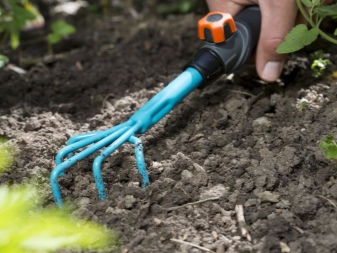

Traditional methods
It is recommended to resort to these methods of struggle only at the initial stages of defeat - in advanced cases, the methods described below will not bring the desired effect.
Recipes for solutions for spraying currants.
- Garlic tincture. To prepare the solution, you need to clean and chop 3-4 cloves of garlic, then pour them with 3 liters of hot water. The solution should be allowed to stand for a week, after which the branches should be irrigated with a spray bottle. The garlic composition is harmless - it can be used at any time, regardless of the stage of development of the shrub.
- Onion tincture. To prepare the solution, you need to peel and chop 3 medium onion heads and pour 5 liters of boiling water over them. After 3 days, the composition should be filtered and sprayed over the shoots. The pungent onion smell is unpleasant for butterflies, it will scare them away.
- Wormwood tincture. To prepare the solution, fill ¼ buckets with wormwood, pour hot water over it and let it brew for 2 days. The resulting composition is used for spraying shrubs during their flowering and fruiting.
- Citrus tincture. To prepare it, you need to take 100 grams of any dry citrus peels and a liter of boiling water. The zest should be poured with water and left for 5 days in a dark and cool place. The first spraying is recommended in mid-May, after which another 2-3 treatments are carried out with an interval of 2 weeks.
The glassware is scared off by harsh aromas, therefore, for spraying currants, you can use products with persistent and rich odors, for example, a decoction of tansy or needles. To scare off pests, you can place containers with sand soaked in kerosene, vinegar or ammonia between the bushes.
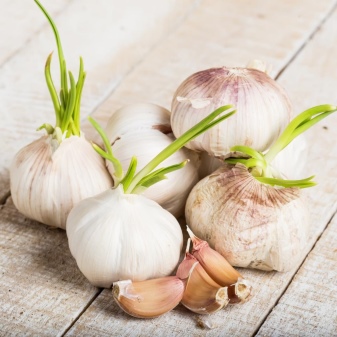
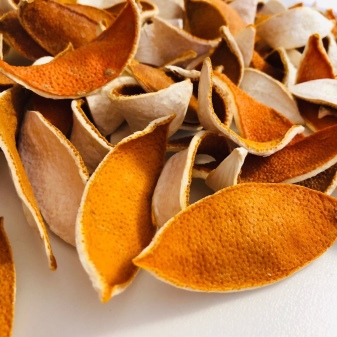
Ready-made preparations
Biological or chemical agents can be used to treat currants for glass disease. The first are based on toxins from fungal cultures. When an insect enters the stomach, they paralyze the intestines, and the insect dies. For shrubs and fruits, such preparations are safe, therefore they are in demand among gardeners. Here are some popular drugs.
- "Agravertine". It is a transparent emulsion packaged in glass ampoules with a volume of 5 and 10 ml. The drug is not addictive, and pests cannot adapt to its active components: all this allows the use of "Agravertin" over a long period of time. To prepare a working solution, you need to dilute 5 ml of the product in 5 liters of water. It is recommended to repeat the treatment after 14 days.
- "Lepidocide". The drug is available in several forms: powder, suspension. Modified versions of the suspension concentrate are also available on the market. The drug is safe for plants and humans, since its components do not accumulate in fruits. To spray plants, you need to prepare a solution according to the instructions and treat the plants with it. After 2 weeks, the procedure must be repeated.
- "Bitoxibacillin". The drug is presented in suspension and powder. The product has low toxicity to bees. It is harmless to humans and garden plants. It can be used at any stage of the growing season of shrubs. To prepare a working solution, you need to dilute 30 ml of the drug in 5 liters of water. Only a freshly prepared composition is suitable for processing shrubs.
- Fitoverm. This is the latest generation biological insectoacaricide. The tool is highly effective: it kills almost all garden pests, including spider mites. To prepare the solution in a bucket of water, dissolve 2 ml of the drug, stir thoroughly and treat the upper and lower shoots of currants with the resulting composition. After 10-14 days, the manipulation must be repeated.
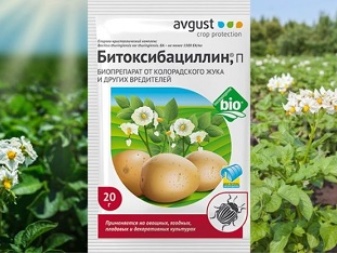
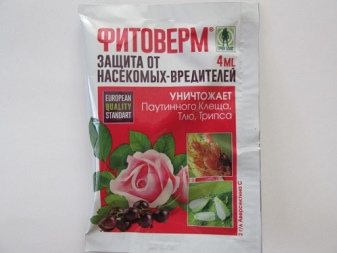
If the glass case has spread a lot and occupied the currant bushes, then only chemical preparations can help. They are able to stop the rapid spread of pests in a short time and significantly reduce the lesions. Such substances are dangerous to humans, therefore they should be sprayed carefully using personal protective equipment. Since their toxic components accumulate in berries, it is allowed to process currants about a month before picking berries.
Effective drugs.
- Iskra M. To prepare the solution, you need to dilute 10 ml of the poison in a bucket of water. To consolidate the result after 7 days, it is recommended to re-spray.
- "Karbofos"... This is a drug with a complex action: insecticide and acaricide. It is a colorless oily liquid. The first treatment is recommended to be performed in the spring during active foliage blooming. To prepare the working solution, dilute 75 ml of "Karbofos" in 10 liters of water. For processing 1 bush, you need 1.5 liters of solution.
- "Fufanon". A drug with a wide range of action. Differs in high efficiency. Threat to bees. To prepare a solution, you need to take 10-12 ml of the product per 10 liters of water. It is recommended to process shrubs no more than 2 times.
It is necessary to spray currants with biological and chemical preparations in dry and calm weather.
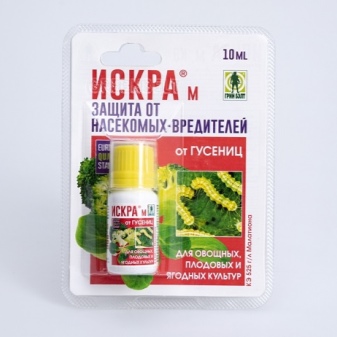
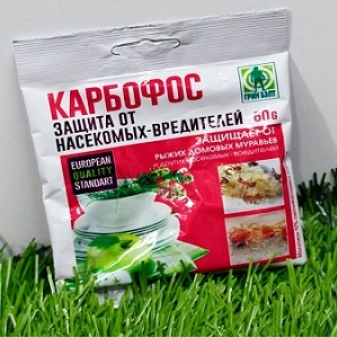
Preventive measures
It is difficult to deal with the glass - it is easier to resort to preventive measures and prevent the occurrence of pest butterflies... First of all, you need to carefully inspect new bushes before planting: they must be healthy, with well-developed leaf plates, without external damage. It is best to buy planting material in trusted stores.
Weeds should not be allowed to grow near the bush. The grass must be pulled out regularly and the soil must be loosened. A couple of times a season, when digging up soil near a shrub, wood ash should be poured. Shrubs must be regularly inspected, and if dried shoots are found, cut them off at the base and process them with garden pitch. If 40% of the plant or more is affected by the glass, the bush should be uprooted and burned.
To reduce the risks of damage by glass, between red and black currants, gooseberries and raspberries, you need to plant elderberry, garlic, saffron or other plants with a pungent odor.
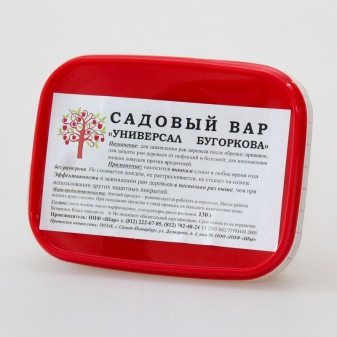
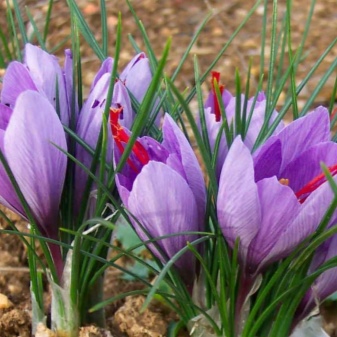









The comment was sent successfully.